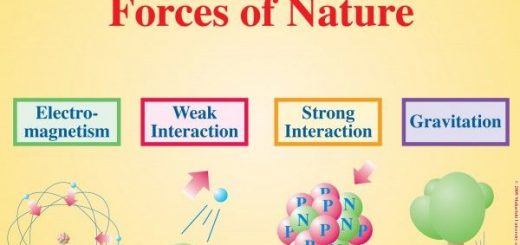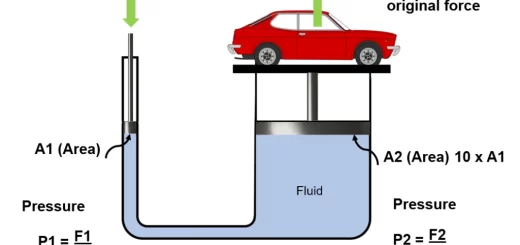Electrical current, Potential difference, Electric resistance and Ohm’s law
The electric current is a flow of electric charges through a conducting material, The electric current flows from the positive pole to the negative pole outside the source & it is called the conventional direction of electric current, however, it is opposite to the direction of electrons flow.
Electric current intensity
The electric current depends on the existence of free electrons move through a conducting material that permits the flow of electric current, The electric current intensity expresses the quantity of electricity passing through a cross-section of a conductor in one second.
The conventional direction of electric current: The current direction is from the positive pole to the negative pole outside the electric source.
The actual direction of electric current: The electrons direction is from the negative pole to the positive pole outside the electric source.
The electric current intensity (I) is the quantity of electricity passing through a cross-section of a conductor in one second, The electric current intensity (I) passing through a conductor is determined from the relation:
I = Q / t
Where: (Q) quantity of electricity and measured in Coulomb (C), (t) time and measured in second (s), Thus, The electric current intensity is measured in Coulomb/second which is equivalent to Ampere (A).
1 Ampere = 1 Coulomb / 1 second
Ampere is the electric current intensity due to the flow of quantity of electricity of 1 Coulomb through the cross-section of the conductor in one second, Coulomb is the quantity of electric charge that when passes through a cross-section of a conductor in a period of one second it produces an electric current of 1 Ampere.
When the electric current passing in a conductor = 10 Ampere, It means that the quantity of electric charge passing through the cross-section of the conductor in one second = 10 Coulomb.
The electric current intensity passing in electric circuit is measured using the ammeter which is connected in series in the electric circuit, The number of electrons (N) passing through a certain cross-section of a conductor can be calculated from the relation, Where (e) is the electron charge and equals 1.6 × 10−19 C:
N = Q / e
The potential difference
The electric current passes in a conductor when the electric potential at a point in the conductor is different than it is at another point which means when there is a potential difference between the two points, The potential difference between two points (V) is the work done to transfer a quantity of charge of 1 Coulomb between two points, The electric potential difference (V) is determined by the relation:
V = W / Q
Where: ( W) is the work done and measured in Joule (J), (Q) quantity of charge and measured in Coulomb (C), Consequently, the electric potential difference is measured in Joule/Coulomb which is equivalent to Volt (V).
1 Volt = 1 Joule / 1 Coulomb
The volt is the potential difference between two points when a work of 1 Joule is done to transfer a quantity of electricity of 1 Coulomb between these two points, The electric potential difference between two points is measured using a device called a voltmeter connected in parallel in the electric circuits.
When the potential difference between the ends of a conductor = 25 v, It means that the work done to transfer a charge of 1 C between the ends of the conductor = 25 J.
Electric energy and the electric power:
V = W / Q , W = V Q = V I t
Where: W (the work done) represents the consumed electric energy that is measured in Joule and equivalent to Volt.Ampere.second, The electric energy consumed in 1 second is known as the electric power (Pw), It is measured in Watt which is equivalent to Joule/second.
Pw = V I = W / t
The electric resistance
When an electric current passes in a conductor, it suffers a resistance or opposition to its flow which is called the electric resistance, The electric resistance (R) is the opposition to the flow of the electric current when it passes in a conductor.
There are two types of resistances which are constant resistance and variable resistance, The electric resistance is measured in Ohm, The electric resistance of a conductor (R) is determined by the relation, which is known as Ohm’s law:
R = V / I
Ohm’s law
When the electric circuit is used to find the relation between the potential difference at the terminals of a conductor and the electric current intensity passing through it, we find that the electric current intensity passing in a conductor is directly proportional to the electric potential difference at its terminals.
Ohm’s law: At constant temperature, the electric current intensity passing in a conductor is directly proportional to the potential difference between its terminals.
The electric resistance (R): The ratio between the potential difference between the terminals of the conductor in Volts and the electric current intensity passing through it in Amperes.
The measuring unit of resistance is called Ohm, Ohm is the resistance of a conductor that permits the flow of a current intensity 1 A when the potential difference between its ends 1 V.
When the electric resistance of a conductor = 100 Ω, the ratio between the potential difference between the ends of the conductor and the electric current intensity passing through it = 100 V/A.
Deduction of the electric resistance of a conductor
The electric resistance is directly proportional to the length of the conductor: R ∝ l.
The electric resistance is inversely proportional to the cross-section of the conductor: R ∝ I / A.
R ∝ l / A , R = Constant × l / A
R = ρe l / A
Where: ρe is a physical quantity constant for the same material at constant temperature and called the resistivity for the material of the conductor.
The factors affecting the electric resistance of a conductor at a constant temperature
- The resistivity of the conductor or type of material of the conductor (ρe).
- Conductor length (l), directly proportional.
- Cross-section of the conductor (A), (inversely proportional).
Rise in temperature of the conductor increases its electric resistance, Because the rise in temperature increases the amplitude of vibration of the metal molecules and its speed of vibration which increases the rate of collision of the electric current electrons with the metal molecules that increases the opposition for the flow of electrons through it and increases the electric resistance of the conductor.
The resistivity of the conductor material
The resistivity is considered a characteristic physical property of the material, as the resistivity changes the type or temperature of the material of the conductor changes, The resistivity (ρe) is the resistance of a conductor of length 1m and its cross-section area 1 m² at a certain temperature, The resistivity is measured in Ω.m.
The factors affecting the resistivity:
- Type of material of the conductor.
- The temperature of the conductor.
When the resistivity of the material of a conductor = 6 × 10−19 Ω.m, The resistance of a conductor of length 1 m and its cross-section area 1 m² at a certain temperature = 6 × 10−19 Ω.
Reciprocal of the resistivity of the conductor material is called the electric conductivity of the conductor material (σ) and it is a physical quantity constant for the same material of the conductor at a certain temperature, So, it is a physical property characteristic for it.
The electric conductivity (σ) is the reciprocal of the resistance of a conductor of length 1 m and its cross-section area 1 m² at a certain temperature or it is the reciprocal of the resistivity of the conductor material, The electrical conductivity for the material of a conductor is measured in Ω −1.m −1.
When the electrical conductivity of copper = 5.6 × 107 Ω −1.m −1, The reciprocal of the resistance of a copper conductor of length 1 m and its cross-section area 1 m² at a certain temperature = 5.6 × 107 Ω −1.
Factors affecting the electrical conductivity of a conductor material:
- Type of martial of the conductor.
- The temperature of the conductor.
When the temperature of the conductor increases, its resistivity increases & its conductivity decreases, The electric transmission cables are made of copper, Because the resistivity of copper is small which means that the resistance of the copper wires is small as well, where (R ∝ ρe), That means that the electric conductivity of copper is high, thus decreases the losses in electric energy.
To determine the resistance R using mass, volume & density of the material:
R = ρe l / A = ρe l² / Vol = ρe l² ρ / m
R = ρe l / A = ρe Vol / A² = ρe m / ρ A²
When a wire is stretched its length increases and its cross-section area decreases.
l1 / l2 = A2 / A1
The resistivity is constant.
R1 / R2 = l1 A2 / l2 A1 = l1² / l2² = A2² / A1²
Resistances connection (series & parallel), Electric energy and Electric power



